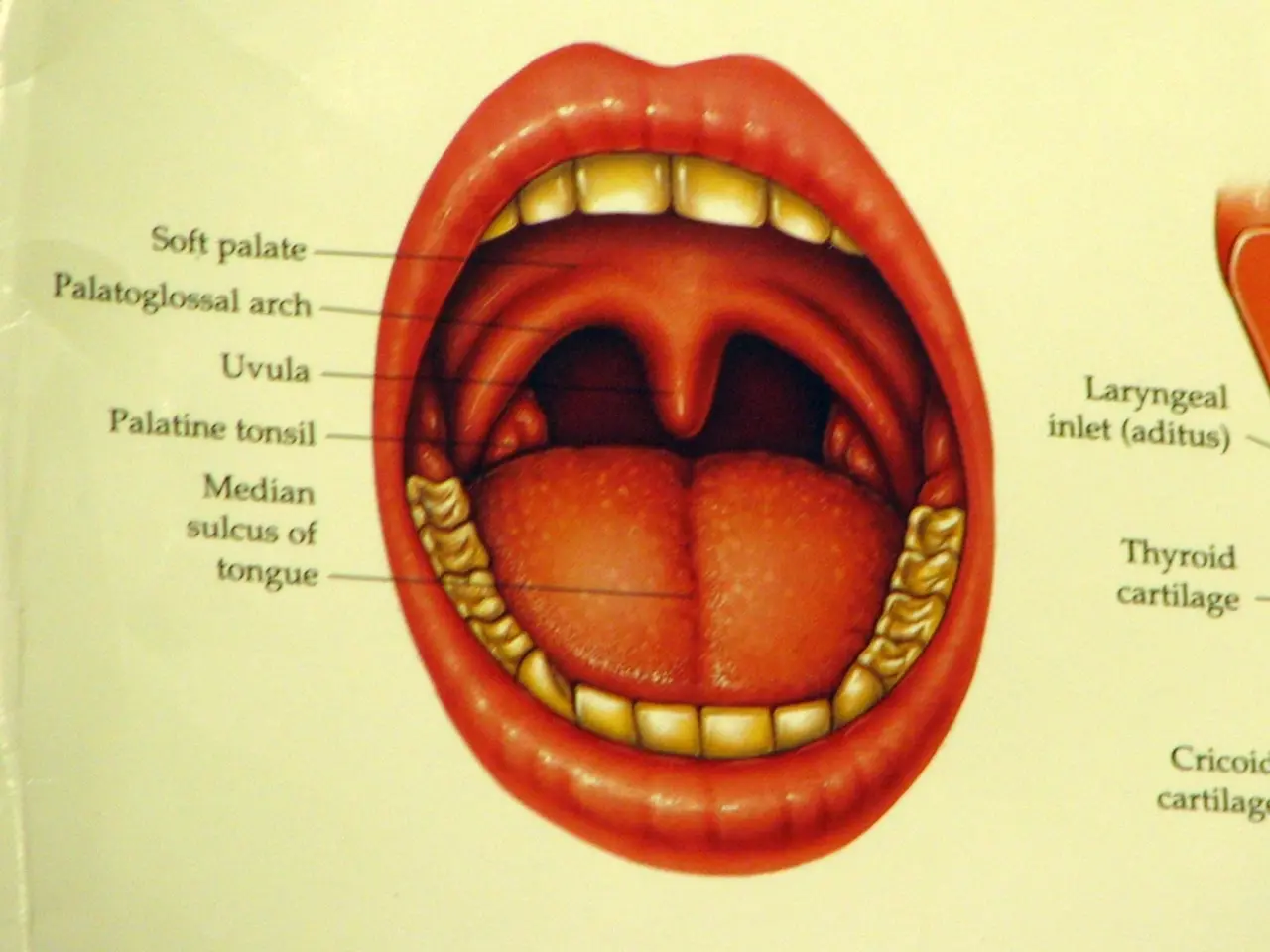Pregnancy-Related Fibroids: Their Signals, Impacts, and Interventions
**Pregnancy, Fetal Development, and Delivery Impacted by Fibroids**
Fibroids, noncancerous uterine tumors, are common among women of reproductive age. During pregnancy, these growths can influence both maternal and fetal health, though their impact varies depending on size, number, and location.
**Risks for Maternal and Fetal Health**
- **Miscarriage Risk:** Women with fibroids have a higher miscarriage rate (14%) than those without (7.6%), particularly if the fibroids are large or located near the placenta[1]. - **Premature Birth and Fetal Growth Concerns:** There is a higher risk of early labor, fetal growth restriction, and a greater chance of needing a Cesarean section, particularly with larger, placenta-adjacent, or lower uterine fibroids[1][3]. - **Delivery Complications:** Fibroids may interfere with the baby's position (e.g., causing breech presentation), block the birth canal, or hinder uterine contractions, all of which can complicate labor and delivery[1][4]. They may also increase the risk of placenta previa, placental abruption, and postpartum hemorrhage[1]. - **Uncomplicated Pregnancies:** Importantly, **most women with fibroids have uneventful pregnancies and deliveries**[2][3]. Only certain types and locations (especially submucosal or intramural, close to the lining or wall) are linked to complications[3].
**Fetal Development**
- **Direct Effects:** There is little evidence that fibroids directly harm fetal development unless they cause significant placental interference or growth restriction, which is uncommon[1]. - **Positional Issues:** Fibroids can physically push the baby into a non-optimal position, increasing the likelihood of C-section[1][3]. - **Placental Problems:** If the placenta attaches over or near a fibroid, there is a higher risk of growth restriction and placental complications, such as abruption or previa[1].
**Treatment Options During Pregnancy**
**Management Approach**
Most fibroid-related complications in pregnancy are managed expectantly due to the risks of intervention during gestation[2]. Treatment generally focuses on symptom relief and monitoring for complications.
**Monitoring**
- **Ultrasound:** Regular ultrasounds to monitor fibroid size and fetal growth. - **Signs of Concern:** Watch for signs of preterm labor, placental complications, or fetal distress.
**Medications**
- **Pain Relief:** Acetaminophen and other pregnancy-safe pain relievers may be used for discomfort. Nonsteroidal anti-inflammatory drugs (NSAIDs) are generally avoided, especially in the third trimester. - **Hormonal Therapies:** Drugs like gonadotropin-releasing hormone agonists (GnRHa) can shrink fibroids, but they are **not routinely used during pregnancy** due to significant side effects and lack of safety data for the fetus[2]. - **Tocolytics:** If preterm labor occurs, medications may be used to delay delivery and allow further fetal development.
**Procedural Interventions**
- **During Pregnancy:** Surgical removal of fibroids (myomectomy) is almost never performed during pregnancy due to high risks of hemorrhage and miscarriage[2]. - **Postpartum:** After delivery, fibroids may be addressed if they persist and cause symptoms.
**Delivery Planning**
- **Vaginal Delivery:** Often possible if fibroids are small and not obstructing, but C-section may be necessary if there are positional issues or fibroids block the birth canal[1][3]. - **Excessive Bleeding:** Preparations should be made for possible postpartum hemorrhage due to impaired uterine contraction.
**Prognosis**
The majority of pregnancies with fibroids proceed without major complications, especially with vigilant prenatal care[1][2][3]. Risks are higher for those with large, numerous, or strategically located fibroids. Individualized management, including close fetal monitoring and delivery planning, is crucial for optimizing outcomes.
---
**In summary:** Fibroids during pregnancy can increase risks of miscarriage, preterm birth, fetal growth problems, and delivery complications, particularly when they are large, numerous, or located near the placenta or cervix. Most cases, however, proceed normally. Treatment focuses on monitoring and symptom management, as surgical and hormonal interventions are rarely used during pregnancy due to safety concerns. Delivery plans should be individualized based on fibroid size and location[1][2][3]. Fibroids may affect conception by obstructing the fallopian tubules, and maintaining a healthful diet and minimizing time spent in polluted environments may help reduce the risk of developing fibroids. Artificially sweetened, processed, and preserved food products may increase the risk of developing fibroids. Fibroids, or leiomyomas, are noncancerous tumors that grow in the womb. The levonorgestrel intrauterine device (IUD) is currently the preferred hormonal treatment for fibroids due to its fewer side effects, but the mechanisms of hormonal contraceptives against fibroids are still not fully understood. During pregnancy, symptoms of fibroids can include severe cramps, widespread pain and tension in the stomach, digestion problems, increased need to urinate if the fibroids exert pressure on the bladder, difficulty urinating, and back pain. In those who are symptomatic, the main indication of fibroids is abnormal bleeding in the form of heavy or extended menstrual bleeding. If fibroids are identified before conception, treatments such as hormone therapy, surgery, high intensity ultrasound treatment, uterine fibroid embolization, or GnRH leuprolide may be used to treat them temporarily. GnRH leuprolide can shrink fibroids by causing the uterus to decrease in size, but it cannot be taken for more than a certain period due to side effects.
[1] Thorp JM, et al. The impact of fibroids on pregnancy and outcomes: a systematic review. Obstet Gynecol. 2015;125(4):773-787. [2] American College of Obstetricians and Gynecologists (ACOG). Fibroids: Diagnosis and Treatment. Committee Opinion No. 659. Obstet Gynecol. 2015;126(3):e83-e91. [3] American Society for Reproductive Medicine (ASRM). Management of uterine fibroids: an ASRM practice committee clinical management guideline. Fertil Steril. 2017;108(5):905-922. [4] Thorp JM, et al. Fibroids and labor and delivery: a systematic review. Obstet Gynecol. 2014;124(5):1022-1032.
- Women in their reproductive age with fibroids, uterine growths, may experience increased risks during pregnancy.
- Large or strategically placed fibroids can lead to higher miscarriage rates, premature birth, fetal growth problems, and delivery complications.
- Treatment strategies for fibroids during pregnancy focus on monitoring and symptom management due to limitations of surgical and hormonal interventions.
- Regular ultrasounds and watching for signs of preterm labor, placental complications, or fetal distress are essential parts of prenatal care for women with fibroids.
- The levonorgestrel intrauterine device (IUD) and a healthful diet are potential approaches for reducing fibroid risks before conception.
- To minimize the risk of developing fibroids, it's recommended to avoid artificially sweetened, processed, and preserved food products.
- Science and research aimed at fibroids, women's health, health-and-wellness, therapies-and-treatments, and HIV remain crucial for optimizing the understanding and management of fibroids.




